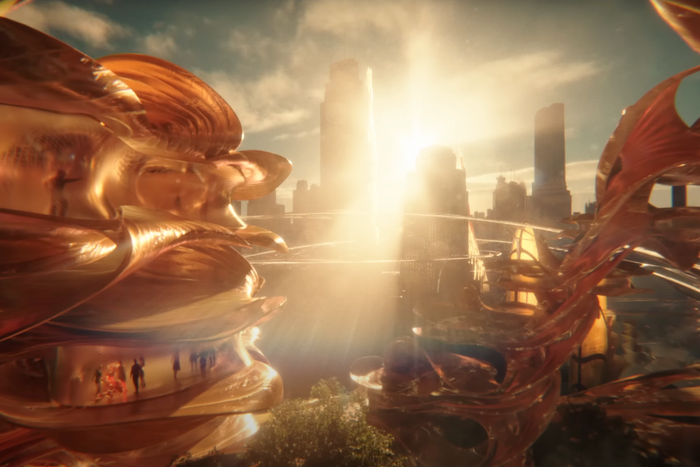
Of all the elements of Francis Ford Coppola’s Megalopolis, none is perhaps as confusing as its architecture. Coppola’s “New Rome” — a decadent iteration of New York City — is a jumbled pastiche of 1920s Art Deco (the protagonist, architect Cesar Catilina, played by Adam Driver, does all his work in the spire of the Chrysler Building), 1970s grittiness, 1980s Postmodernism (lots of ruins and columns, all of which appear rather ersatz), and, of course, the plush Roman chintz that would be equally at home in a bad Versace ad or some of the restaurant scenes in The Godfather.
The central question of the film is ostensibly “What should the future look like?” In answering this, one might expect Coppola to invoke something contemporaneous to the film’s mixed timelines — an Art Deco Oz, perhaps — or something vaguely neo-futurist, maybe some swoopy towers in a park? The actual choice is neither. Instead, Catilina’s vision of Megalopolis, which he pitches to the city as a ground-up new neighborhood à la Hudson Yards, is of swirling, pulsing organic forms that sprout out of a blobby landscape executed in the blurry, perpetually sunset-lit visual language of the computer rendering. It’s not a future from the 1920s or the 1970s, but one that is, unfortunately, from our own time. Namely, it is the work of Neri Oxman, who was the architectural consultant on the project and appears in a cameo in the film.
If you’re not familiar with her work, Oxman is best known for coining the term “Material Ecology,” which she defines as an approach in which “products and buildings are biologically informed and digitally engineered by, with and for, Nature.” Nature, here, is broadly defined as anything organically derived such as fabrics, silk, fungi, etc. What this looks like for Oxman varies, but has so far consisted of baubles and design objects partially fashioned from organic compounds with the help of trendy technologies such as 3-D printing. For example, Oxman’s “Totems,” which she says “[seek] to address and speculate upon designers’ ability to chemically synthesize the ‘pigment of life’” — literally and metaphorically — and “program its interaction across scales and species,” are essentially marbles formed out of melanin extracted from animal parts, which is then synthesized in a lab and 3-D printed into acrylic orbs. While this sounds interesting in theory, the end result is nothing more than a pretty toy in which a substance that defines a major facet of human and animal diversity is stripped of its context and made consumable. Similarly, her “Vespers III” death masks use 3-D-printed “bioactive materials” to create spectacular insectoid forms that mimic the intricate geometries of life forms through the use of algorithms and data science. Weaving together biological processes with intensely technological ones, the death mask is ham-fistedly framed as a site of new life. The end result of Oxman’s process is always an uncanny artifact of technofetishism, in which the object looks “natural,” e.g., growth-like, botanical, or animalian, and simultaneously technological, e.g., complex or difficult to fabricate. Regardless of the outcome, the common dream of Oxman’s work is, ultimately, to fabricate objects and architectures that can be “grown” organically and technologically rather than by the messier reality of human hands.
There is and has always been something ironic in all of this, which is that the technology, whether it’s extracting melanin or directing bacteria to generate specific colors, is used with little apparent ethical deliberation. It pretends that science is neutral, and assumes that the application of “nature” (already a problematic concept) or more specifically, the organically derived, is always something positive or at least indifferent. With “nature” and the computer as designer, any accountability for the outcome of these experiments is mostly (and thankfully) taken away from the user or designer herself. Working at a larger scale, Oxman recently showed up in Dezeen with a Megalopolis-like rendering of a “conceptual skyscraper” consisting of saucer-like forms suspended in mid-air, calling it the product of “ecological programming.” Per Dezeen, this skyscraper “utilises computation to generate layouts accounting for sunlight, wind, contamination and other factors in order to optimise the health of the ecosystems and positive benefits to the city — from increasing biodiversity to improving urban heat.” The punchline here is that Oxman decided to employ water-guzzling, energy-burning AI in pursuit of these ecological goals, and the building itself looks like it hasn’t been designed for energy or material efficiency or, for that matter, any climate condition in the real world. Instead of confronting any aspect of humanity’s exploitation of natural resources, Oxman creates products that placate people with shiny, technological fixes. It makes sense that Coppola, in his film about a singular great auteur challenging the vulgar, materialistic world, would be drawn to such a frictionless, utopian architectural language.
Megalopolis itself is beholden to the same contradictions as Oxman’s work. Consider Megalon — a half-organic compound dreamed up by Catilina that can heal wounds, fashion structures, and stop time. It absolutely fits in the Oxman mold. Like Oxman, Catilina does not debate the ethics or consequences of using this quasi-organic compound. Organic and limitless, the material seems to adapt itself to any situation, a miracle substance that can only be the stuff of pure fantasy. This is intentional. If Megalopolis can play this Oxmanian sleight of hand between technology and nature, if it somehow enable structures to be grown (natural) rather than built (artificial), it can be invested with the dual authority of both nature and science, harnessed for a vague but unilateral idea of “progress.” It’s wildly different from the vision of Catilina’s rival, Mayor Cicero, who is plugging a bawdy ’90s theme-park casino at the beginning of the film. But we don’t need to worry about Cicero. It is owing to the trump card of the Megalon as both miracle material and beacon of unassailable progress that any opposition to Catilina by Cicero simply fizzles away, and Megalopolis appears in the final scenes fully realized, as if Catilina simply had to wave his hands around to make it real. Ultimately, both Megalon and Megalopolis are emblematic of an architecture that eliminates human labor and material constraints altogether. It is not enough that Catilina is an architect. He controls nature — he controls time! — and therefore is invested with the agency that designers in real life will never have, because architecture is always social and rooted in material reality.
For most viewers, none of this tension may be apparent. Although the real architect of Megalopolis is Oxman, in the film, she is relegated to being a nurse-like figure to Catilina’s wounded genius. It’s a bit of an anticlimactic public reemergence for Oxman, who has been embroiled in two scandals — the first, in 2019, for taking funds from Jeffrey Epstein for the MIT Media Lab, where she was a tenured professor, and secondly, for alleged instances of plagiarism in her dissertation, after her husband, billionaire hedge-fund manager Bill Ackman, attacked then-president of Harvard Claudine Gay over similar accusations.
And yet it is somehow fitting that Oxman has such an outsize role in this regressive film, in which the women are either schemers, like Catilina’s ex, Wow Platinum, or virtuous wives, like his new and nubile lover, Julia, Mayor Cicero’s daughter. In a universe where male desire and fantasy are so absolute, architecture is mostly a device to project Adam Driver’s face over the city, in a nimbus-like structure that will keep growing, unchecked, unopposed; great and inevitable.

